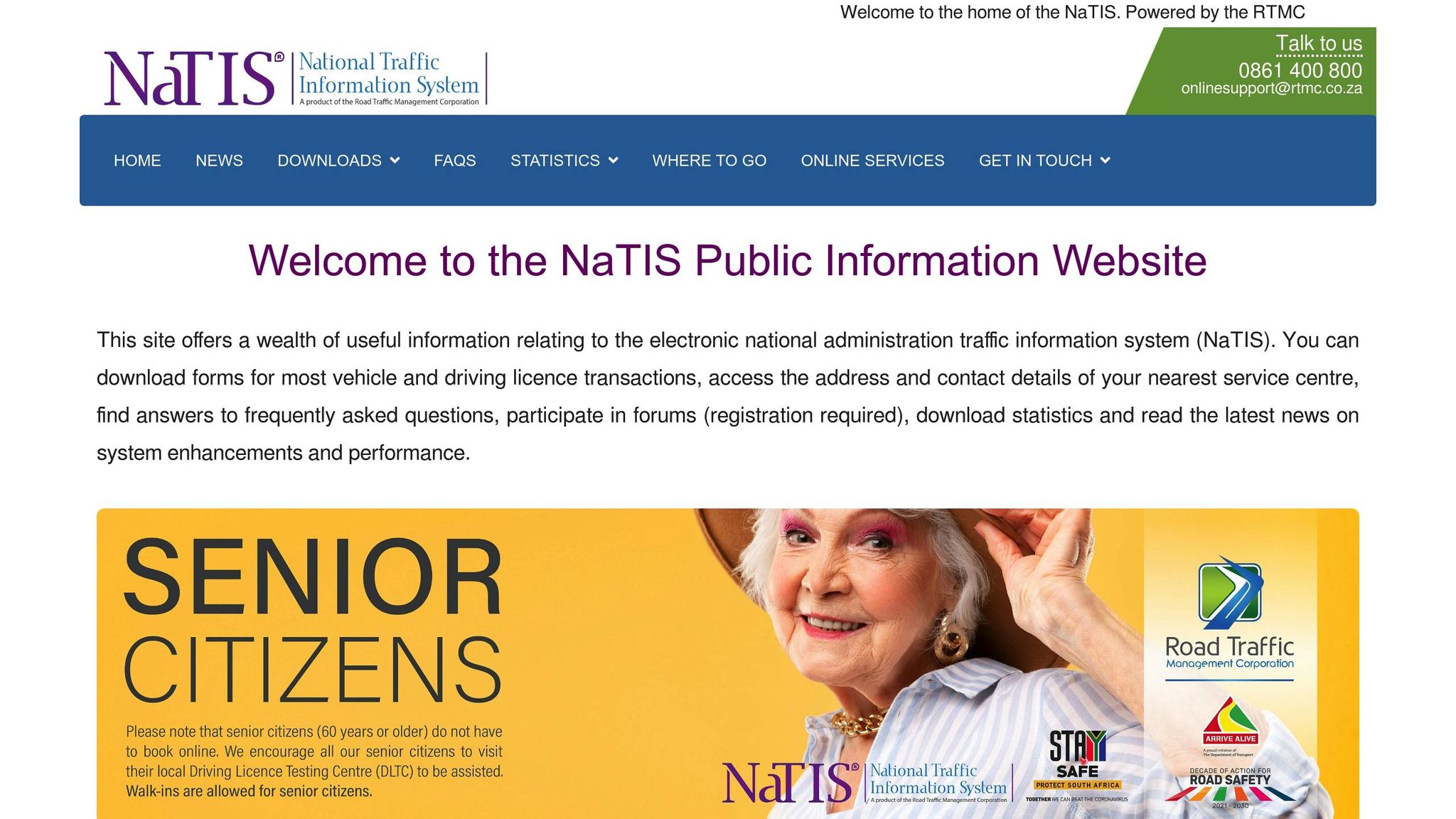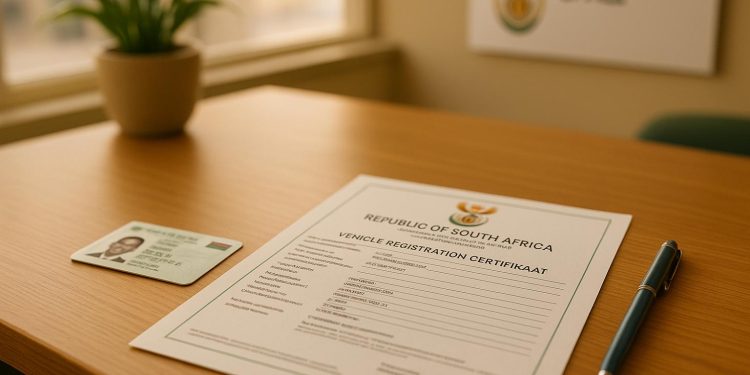In South Africa, transferring car ownership is a legal requirement managed through NaTIS. Both buyers and sellers must notify authorities within 21 days to avoid fines or liabilities. Here’s a quick summary of what you need:
- Seller’s Tasks: Submit the Notification of Change of Ownership (NCO) form, hand over the Vehicle Registration Certificate (RC1), and provide a certified ID copy and proof of residence.
- Buyer’s Tasks: Complete the Application for Registration and Licensing of Motor Vehicle (RLV) form, present a valid Roadworthy Certificate, ID, proof of residence, and pay any outstanding fines or fees.
- Special Situations: Extra documents may apply for company-owned vehicles, deceased estates, or imported cars.
Missed deadlines can lead to penalties, so act promptly. Ensure all documents are accurate, and visit your local licensing office to finalize the process.
What is a NaTIS document and why do you need it?

Required Documents and Preparation
Getting your paperwork in order is crucial to avoid delays when transferring vehicle ownership. The NaTIS system has specific requirements for both buyers and sellers, and missing even one document can bring the process to a halt. Below is a breakdown of the necessary documents and special cases to help streamline the process.
Documents You Need for Ownership Transfer
The Vehicle Registration Certificate (RC1) is the cornerstone of any ownership transfer. This "blue book" contains all the essential details about the vehicle and serves as proof of current ownership. Only the original document is accepted – photocopies won’t work.
Two forms are required to complete the transfer: the seller must fill out the Notification of Change of Ownership (NCO) form, while the buyer completes the Application for Registration and Licensing of Motor Vehicle (RLV) form. These forms can be picked up at local licensing offices or downloaded from provincial traffic department websites.
A valid Roadworthy Certificate is also mandatory. This certificate, which costs between R500 and R800, must be issued within 60 days of the transfer date and confirms the vehicle meets South Africa’s safety standards. You can obtain it from authorized testing stations.
Both parties need to provide identity documents. South African citizens must present their green ID book or smart ID card. Buyers also need proof of residence, dated within the last three months, such as a utility bill, municipal account, or bank statement.
Additionally, you’ll need proof of payment for any outstanding traffic fines or licensing fees. The NaTIS system will flag unpaid amounts, and the transfer cannot proceed until these are settled. Checking the eNaTIS online portal beforehand can save time.
If the vehicle is financed, a settlement letter from the financial institution is required. This letter must confirm the loan has been fully paid, be on the bank’s official letterhead, and be dated within 30 days of the transfer.
Extra Requirements for Special Cases
Certain situations require additional documentation:
- Foreign nationals must provide a valid passport, a temporary or permanent residence permit, and a letter from their employer or educational institution confirming their status in South Africa. Proof of address for non-citizens must be dated within the last six months.
- Company-owned vehicles require the company’s registration certificate (CK1), a board resolution authorizing the sale, and the ID of the person signing on behalf of the company. The signatory must be listed as an authorized representative in the company’s records.
- Deceased estate transfers involve extra steps. You’ll need the deceased’s death certificate, a letter of executorship or administration from the Master of the High Court, and an affidavit from the executor confirming their authority to transfer the vehicle. These transfers typically take longer due to additional verification.
- Vehicles imported from other countries need customs clearance certificates, import permits from the South African Revenue Service (SARS), and translated registration documents (if they’re not in English). Translations must be done by a sworn translator.
- Classic or modified vehicles may require engineering certificates or modification approvals from the Department of Transport. These documents confirm that any changes made to the vehicle meet South African safety and vehicle standards.
To avoid delays, gather all necessary documents in advance and double-check their validity. Keep originals separate from copies, and always use black ink when filling out forms to ensure smooth processing.
Step-by-Step Car Ownership Transfer via NaTIS
Once your documents are ready, transferring car ownership through NaTIS involves a series of steps that both the buyer and seller must follow. Acting promptly is key to avoiding legal issues or extra fees. Here’s a breakdown of the process for both parties.
Step 1: Gather and Verify Your Documents
Before heading to the licensing office, double-check that all your documents meet NaTIS requirements. Ensure the information is consistent across all paperwork, and organize both originals and copies. Keep in mind that only original documents will be accepted.
Step 2: Responsibilities of the Seller
The seller is required to fill out and submit the Notification of Change of Ownership (NCO) form. This yellow form is critical for transferring legal responsibility for the vehicle and must be signed by both the buyer and the seller. It’s best to complete Section A together to ensure accuracy.
Submit the NCO form to your nearest registering authority within 21 days of the sale. Additionally, hand over the original vehicle registration certificate (RC1) to the buyer, along with a certified copy of your ID and proof of residence. Keep a copy of the completed NCO form for your records. Lastly, notify your insurance provider about the sale to avoid any future liability.
Step 3: Responsibilities of the Buyer
As the buyer, you’ll need to complete the Application for Registration and Licensing of Motor Vehicle (RLV) form. This document is essential for updating the vehicle’s registration in your name.
When filling out the RLV form, make sure all details match your ID exactly. Bring your original ID, recent proof of residence (dated within the last three months), and the original RC1 certificate provided by the seller. It’s also a good idea to contact your local licensing office ahead of time to confirm the total fees, which typically include transfer charges, administrative costs, and the annual licensing fee for the current period.
Step 4: Submit Documents and Finalize the Transfer
Take all your documents to the nearest registering authority or local licensing office. In some areas, post offices also accept vehicle transfer paperwork, which can be a more convenient option if the licensing office is busy.
Usually, the buyer handles the submission since the registration needs to be updated under their name. If the vehicle is staying in the same area, it’s often more efficient to complete all submissions in one visit. Most applications are processed on the same day, so if everything is in order, you might receive your new registration certificate immediately. Arriving early can save you time, as these offices tend to get crowded, especially toward the end of the month.
The Road Traffic Management Corporation (RTMC) is working on an online system in collaboration with WeBuyCars. This system aims to simplify the process with digital submissions and faster processing times.
Keep in mind that procedures may vary by province and are subject to change, so it’s always a good idea to check with your local licensing department for any additional requirements.
sbb-itb-09752ea
Fees, Timelines, and Legal Requirements
Once your documents are ready and you’ve completed the transfer steps, it’s time to focus on the fees and deadlines. These details are critical to ensure the process is finalized smoothly and without any extra costs.
Transfer Fees and Costs
Transferring vehicle ownership comes with specific fees, which you’ll need to pay at your local licensing office or post office. The ownership transfer fee is capped at R330, making it one of the more straightforward expenses to anticipate.
You’ll also need a roadworthy certificate, which typically costs between R500 and R800. Beyond that, annual vehicle license fees vary depending on your province and the type of vehicle, ranging anywhere from R500 to R1,500.
Most licensing offices and post offices accept payments via cash or card. Alternatively, third-party services like Fines SA provide online payment options for handling fees related to ownership transfers. However, it’s always a good idea to confirm the exact costs with your local licensing department, as fees and additional charges can differ depending on your location.
Once you’ve sorted out the fees, it’s equally important to stay on top of the legal deadlines to avoid unnecessary penalties.
Legal Deadlines and Penalties
Both the buyer and seller have 21 days to complete their respective responsibilities. During this period, the seller must submit the NCO (Notification of Change of Ownership) form, while the buyer is required to register the vehicle and pay all associated fees. Missing this deadline can lead to penalty fees and, in some cases, legal liabilities.
If the 21-day window is overlooked, financial penalties kick in. For buyers, failing to register the vehicle on time can result in arrears and additional fees, which may significantly inflate your overall costs. Moreover, not completing the ownership transfer properly could leave you exposed to ongoing legal and financial risks, particularly if there are outstanding fines or incidents involving the vehicle.
To steer clear of these complications, make it a priority to register the vehicle in your name promptly.
Common Problems and Solutions
Transferring vehicle ownership can sometimes hit a few snags. Being aware of potential issues and addressing them promptly can save you time, money, and frustration. Here’s a closer look at some common problems and how to tackle them effectively.
Missing or Incorrect Documents
Lost the original registration certificate? No problem. You can apply for a duplicate at your local licensing department. Bring along valid identification, proof of residence, and an affidavit explaining how it was lost.
Errors like misspelled names, incorrect ID numbers, or outdated addresses can also cause delays. To fix these, visit the licensing department with the correct documents, fill out a correction form, and pay the required fee.
If the vehicle is still under financing, the bank holds the registration certificate. You’ll need to settle any outstanding balance and request a clearance certificate from the bank before proceeding with the transfer.
Unpaid Fees or Fines
Outstanding fines – whether for speeding, parking violations, or unpaid tolls – can block the transfer process. The NaTIS system flags any unresolved fines, so it’s crucial to clear these first.
You can check for unpaid fines at your local licensing office or through the official online portal of the relevant traffic department. Once identified, pay off all fines in full. If you believe a fine is incorrect, you may dispute it, but keep in mind that this could delay the transfer process.
Additionally, ensure the vehicle’s annual license is up to date. If it’s expired, you’ll need to pay any overdue fees and penalties before moving forward.
Roadworthy Certificate Issues
A failed roadworthy inspection can be another hurdle. Common reasons for failure include worn brake pads, broken lights, or a cracked windshield. Address these issues with necessary repairs and schedule a re-inspection.
To avoid disputes, agree in writing who will handle repair costs if the vehicle fails the test. If the certificate expires before the transfer is complete, you’ll need to arrange and pay for a new inspection.
In cases where the validity of a roadworthy certificate is questioned, you can request a re-inspection at a different authorized station. Be prepared to cover additional fees for this process.
Key Points for a Smooth Ownership Transfer
Handling vehicle ownership transfers through NaTIS requires careful planning, prompt action, and accurate paperwork. Missing details or deadlines can lead to legal headaches, so here’s a recap of the critical steps to keep things on track.
Start with your documents. The Vehicle Registration Certificate (RC1) is the cornerstone of the process – think of it as your car’s "title deed". Alongside it, buyers need a certified copy of their South African ID or, for foreign nationals, a valid passport with the correct visa. Proof of residential address is also mandatory. If the utility bill isn’t in the buyer’s name, an affidavit from the bill holder along with the bill itself will suffice.
Stick to the 21-day rule. You’ve got 21 days to notify the authorities – missing this window could leave you open to liabilities. Sellers must file the Notice of Change of Ownership (NCO) form to officially sever ties with the vehicle, while buyers need to submit the Application for Registration and Licensing of Motor Vehicle (RLV) form to establish ownership.
Understand your role. Sellers are responsible for completing the NCO form and obtaining a receipt as proof. Buyers, on the other hand, must fill out the RLV form, submit a valid roadworthy certificate, and ensure all required documents and fees are handed over within the 21-day timeframe.
Avoid mistakes before they happen. Double-check that all names, ID numbers, and addresses match across documents. Make sure the roadworthy certificate is valid throughout the process. These small but crucial steps can save you from delays or complications caused by incomplete or incorrect paperwork.
FAQs
What are the consequences of missing the 21-day deadline for transferring car ownership in South Africa?
If you don’t transfer car ownership within 21 days in South Africa, you could face penalties and fines. On top of that, the seller might still be legally tied to the vehicle, which means they could be held accountable for any traffic offenses or outstanding debts linked to it until the transfer is finalized.
To steer clear of these problems, make sure to submit all necessary paperwork and complete the process through the NaTIS system within the given deadline.
Can I submit the required documents for car ownership transfer online in South Africa?
Yes, in South Africa, you can handle parts of the car ownership transfer process online. Platforms such as the National Traffic Information System (NaTIS) and other authorized services offer digital submission options for the required documents.
Be sure to carefully follow the instructions provided by the platform to ensure your application is processed smoothly. Always double-check that you’re using official or approved services to avoid potential complications.
How do I transfer ownership of a car from a deceased estate in South Africa?
Transferring ownership of a car from a deceased estate in South Africa requires navigating a few essential steps. Start by obtaining Letters of Executorship from the Master of the High Court. This document officially designates an executor to handle the estate, including managing the vehicle’s transfer.
Before proceeding, make sure any debts associated with the car – like unpaid fines or fees – are fully cleared. After that, the executor needs to initiate the ownership transfer through the NaTIS system. This step involves submitting key documents such as the deceased’s death certificate, the executor’s ID, and proof of address. Following these steps carefully will help ensure the process moves smoothly without unnecessary delays.
Related Blog Posts
- How to register a used car in South Africa
- How to Transfer Car Ownership in South Africa: A Complete 2025 Guide
- Car Ownership Transfer in SA: Step-by-Step Process & Fees in 2025
- Vehicle Title Transfer in South Africa: Tips from the RTIA Process





